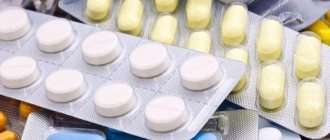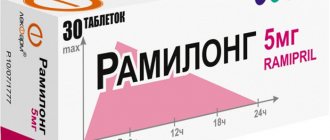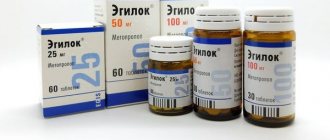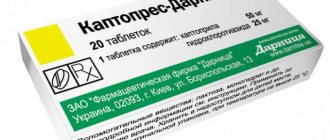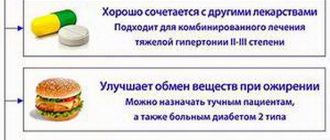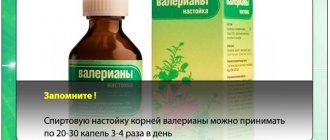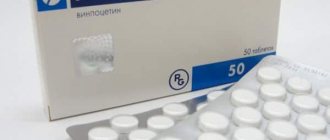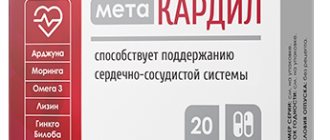At what pressure is the drug used?
Andipal can only be taken with high blood pressure. The drug does not treat hypotension and does not eliminate the causes of the pathology. The main effect of consuming the drug is a decrease in the intensity of symptoms accompanying high blood pressure. For this reason, Andipal is considered as an emergency drug.
The maximum level at which taking the medication is justified is 160 mmHg. At higher levels, it is not recommended to consume Andipal. This is due to the effect of bendazole in the tablets. The substance first increases blood pressure and then lowers it.
Pharmadynamics and pharmacokinetics
Andipal begins to act 15 minutes after administration. This is due to the fact that the active components of the drug are quickly absorbed into the blood. The condition of a person with high blood pressure is normalized by improving cerebral circulation and stopping the release of adrenaline.
Analgin, entering the body, helps reduce the pain symptoms of migraines. The substance also reduces the severity of swelling in soft tissues, which provokes an increase in body temperature.
Papaverine eliminates spasms of smooth muscles in the digestive organs and in the walls of blood vessels. By dilating the arteries, blood flow improves.
Dibazol reduces heart rate and normalizes breathing. Phenobarbital in the drug has a sedative effect on the cells of the central nervous system.
Andipal forte: instructions, reviews, analogues, price in pharmacies
active ingredients: 1 tablet contains metamizole sodium 500 mg (0.5 g), bendazole hydrochloride 40 mg (0.04 g), papaverine hydrochloride 40 mg (0.04 g)
excipients: potato starch, calcium stearate, talc.
Dosage form
Pills.
Basic physical and chemical properties: tablets are white or white with a slight yellowish tint, with a flat surface, beveled edges and notches.
Pharmacological group
Analgesics and antipyretics. Metamizole sodium, combinations without psycholeptics. ATX code N02B B52.
Pharmacological properties
- Pharmacodynamics.
- A combined drug with analgesic, antispasmodic and vasodilating effects due to the specific action of its components. The drug also has a hypotensive and antipyretic effect
- Metamizole sodium is an NSAID (NSAID) of the group of pyrazolone derivatives, has anti-inflammatory, analgesic and antipyretic effects, the mechanism of action of which is due to inhibition of cyclooxygenase (COX) and blocking the synthesis of prostaglandins from arachidonic acid, as well as disruption of the conduction of painful extra- and proprioceptive impulses, increasing the threshold of excitability thalamic centers of pain sensitivity, increased heat transfer.
- Bendazole hydrochloride - has vasodilating, antispasmodic, hypotensive effects, and also has a stimulating effect on the functions of the spinal cord and helps restore the functions of peripheral nerves, and has a moderate immunostimulating effect.
Papaverine hydrochloride has a myotropic antispasmodic, hypotensive effect. Blocks phosphodiesterase, causes the accumulation of cyclic adenosine monophosphate (cAMP) and a decrease in calcium content in the cell, relaxes the smooth muscles of blood vessels and internal organs.
Pharmacokinetics.
When taken orally, it is quickly and completely absorbed. In the intestinal walls it is hydrolyzed to form an active metabolite. The action develops after 20-40 minutes and reaches a maximum after 2:00. Metabolized in the liver. Excreted by the kidneys.
Clinical characteristics
Indications
Pain syndrome associated with spasm of blood vessels or smooth muscles of internal organs.
Contraindications
Known or suspected hypersensitivity to metamizole sodium salt, pyrazolone derivatives (butadione, tribuzone, antipyrine) suspected of acute surgical pathology; anemia of any etiology, cytostatic or infectious neutropenia; leukopenia agranulocytosis thrombocytopenia hepatoporphyria; deficiency of glucose-b-phosphate dehydrogenase; bronchial asthma; respiratory depression, broncho-obstructive syndrome, diseases occurring with decreased muscle tone, convulsive syndrome; glaucoma.
Composition and release form
Andipal is available in the form of round tablets of white or yellowish color. There are distinctive marks on the surface of the tablets. At the pharmacy, the drug is sold in cardboard or paper packages containing 10 tablets of the drug.
1 pill contains the following active ingredients:
- analgin – 0.25g;
- dibazol – 0.02 g;
- papaverine – 0.02 g;
- Phenobarbital – 0.02 g.
Among the auxiliary components of the medication are:
- potato starch – 47.7 mg;
- talc – 9.25 mg;
- stearic acid – 2.9 mg.
Indications for use
The tablets are sold in pharmacies without a doctor's prescription. Indications for taking the medicine:
- hyperthermia accompanied by an inflammatory process;
- increased blood pressure;
- vegetative-vascular dystonia;
- spasms of smooth muscles of the gastrointestinal tract;
- circulatory disorders in the brain.
The medicine is prescribed to reduce pain in the postoperative period, during complex diagnostic procedures and with high blood pressure.
Vasodilator drugs prescribed for osteochondrosis
The work of the muscles of the vascular highways is constantly regulated by nerve impulses passing through sympathetic fibers. These signals are responsible for the muscular activity of almost all internal organs and related functions.
Eliminating stagnation of blood fluid and improving microcirculation in the pathological area makes it possible to normalize metabolic processes and restore the patency of nerve impulses, as a result of which the treatment of osteochondrosis is more effective and the patient’s health condition is stabilized.
Features of the pathogenesis of osteochondrosis disease
Nowadays, osteochondrosis disease (age-related degenerative changes in intervertebral discs) is quite common among the population. This is due to a sedentary lifestyle or, on the contrary, excessively hard physical labor, back injuries, bad habits, poor diet and inadequate sleep.
Initially, the symptoms of osteochondrosis manifest themselves as minor discomfort in the back after physical activity, limited mobility, then pain syndromes become more intense and become chronic. Destructive processes in the intervertebral discs (dehydration and insufficient supply of nutrients) provoke inflammation and swelling of the pathological area (decreased blood circulation in it). The body’s protective reaction to irritation becomes even greater muscle stiffness and pain.
Soft tissue spasms compress sympathetic nerve endings and fibers, the transmission of impulses weakens, the muscle walls of blood vessels do not receive the necessary information and also find themselves in a compressed state. Poor circulation over time leads to oxygen starvation (hypoxia).
Complex conservative treatment of the spine, as a rule, includes taking vasodilating drugs. Results of action of pharmacological agents of the vasodilator group:
- normalization of blood circulation in the pathological area and throughout the body;
- improving the nutrition of soft tissues, saturating them with fluid, accelerating metabolic processes;
- reduction of inflammation and swelling of tissues, congestion and, consequently, pain;
- restoration of the passage of nerve impulses through the fibers.
Mechanisms of drug action
The group of vasodilator drugs used to treat osteochondrosis of the joints is conventionally divided into subgroups:
- substances with myotropic effects that directly affect the muscles of the vascular walls, changing their metabolic processes and reducing tone (caffeine, papaverine, no-spa);
- drugs with neurotropic effects achieve a vasodilating effect through nervous regulation of the tone of blood vessels;
- centrally acting drugs that affect the functioning of the vasomotor center located in the brain (aminazine, apessin);
- peripheral substances:
- blocking vascular adrenergic receptors (phentolamine);
- blocking the transmission of impulses (excitation) from the nerve endings of the sympathetic branches innervating the corresponding blood lines (ornid, octadin);
- improving the transmission of impulses from parasympathetic endings to blood vessels (acetylcholine, carbacholine);
- complicating the transmission of impulses in sympathetic nerve clusters, thereby reducing vascular tone (pentamine, tetamone);
- drugs with a mixed mechanism of action - central neurotropic and peripheral myotropic (nitroglycerin, amyl nitrite, reserpine, the latter weakens the sensitivity of central and peripheral adrenergic receptors responsible for the innervation of blood vessels, expands their lumen, and also lowers blood pressure).
List of main drugs prescribed for osteochondrosis
Actovegin. It has not so much vasodilating properties as stimulating tissue regeneration. It contains many nutrients: amino acids, saccharides, nucleosides. It has a positive effect on the transport, absorption and utilization of glucose and oxygen molecules, and stabilizes the plasma membranes of cells. Restores blood flow in peripheral systems, normalizes and stimulates nutrient metabolism throughout the body, develops and regenerates collaterals (small branches of blood vessels formed during compression or thrombosis of the main channel).
Eufillin. A bronchodilator, it helps relax the muscles of the bronchi, relieves spasms, dilates blood vessels, which makes it indispensable for patients suffering from asthma. Significantly improves blood circulation in the brain and peripheral vessels, and is used to treat diseases of the spine and neurological pathologies. Stimulates the action of the respiratory centers, increases the frequency and intensity of heart contractions, which makes it unsafe for patients with acute heart failure, angina pectoris and cardiac arrhythmias. Can be used for external use in the form of electrophoresis to improve blood microcirculation in pathological areas and restore trophic processes in intervertebral discs.
Pentoxifylline or trental. Improves microcirculation and regenerating properties of blood, thins the blood, reduces total peripheral vascular resistance, dilates the coronary arteries, which accelerates the transport of oxygen throughout the body. By expanding the blood vessels of the lungs, it significantly increases the tone of the muscle fibers responsible for breathing (diaphragm and intercostal muscles). Strengthens collateral blood circulation, increases the concentration of ATP in the brain, and has a beneficial effect on the bioelectrical functions of the central nervous system. The drug is contraindicated in patients with chronically low blood pressure, atherosclerosis and arrhythmia.
Xanthinol nicotinate. Improves cerebral circulation, peripheral (collateral) microcirculation, reduces the manifestations of cerebral hypoxia (insufficient oxygen supply to the brain), normalizes and improves metabolic (metabolic) processes in the brain. Thins the blood and has a beneficial effect on the functioning of the heart.
Thioctic acid, lipoic acid or berlithion. The drug is from a group of vitamin-like substances, similar to those produced by the body, and is close in biochemical properties to vitamin B group. Participates in the regulation of lipid (fat) and carbohydrate metabolism, prevents the deposition of glucose on the walls of blood vessels, improves blood flow and lowers blood viscosity. It has detoxifying properties and has a positive effect on the functions of peripheral nerves and neurovascular bundles innervating internal organs.
Medicines prescribed for cervical osteochondrosis
Symptoms of cervical osteochondrosis primarily affect the blood supply to the brain, the condition of the vertebral arteries, the vertebrobasilar circle, and then can affect the vessels and nerve endings innervating the upper limbs. They are manifested by dizziness, headaches, nausea, coordination disorders, general weakness and fatigue, disturbances in the functioning of the organs of hearing, vision, speech, and smell.
Treatment of cervical osteochondrosis quite often includes nootropic drugs (for example, piracetam, nootropil, vinpocetine), which improve blood circulation in the vessels of the head and improve metabolic processes (carbohydrate and protein) in the brain. They do not always have pronounced vasodilating properties, but they have a beneficial effect on the central nervous system, improve memory, attention, and increase productivity.
Piracetam. It has a positive effect on metabolic reactions in the body, improves blood circulation in the brain, and restores nerve cells. The drug increases energy potential through accelerated ATP metabolism, has a beneficial effect on the central nervous system and is prescribed for diseases of the blood vessels that wash the cerebral cortex.
Vinpocetine. A vasodilator, antihypoxic agent, helps to increase cerebral circulation, especially in ischemic areas by relaxing the smooth muscles of the walls of cerebral vessels. Improves oxygen transport, reduces platelet aggregation and thereby thins blood viscosity.
It is necessary to treat osteochondrosis with complex measures: medications (which, as prescribed by a doctor, may include vasodilators), physiotherapy and physical activity.
The main thing is not to endure the pain, not to delay time, but to contact osteochondrosis treatment clinics in a timely manner. Author: K.M.N., Academician of the Russian Academy of Medical Sciences M.A. Bobyr
Contraindications
In addition to hypotension, Andipal has other contraindications for use:
- blood pathologies – coagulation disorders, anemia;
- all types of glaucoma;
- arrhythmia;
- sensitivity to the components of the drug;
- kidney and liver diseases;
- hereditary disorder of pigment metabolism;
- obstruction of the gastrointestinal tract.
The medicine must not be taken during pregnancy, regardless of trimester. Clinical trials have revealed the harmful effects of the drug's components on the developing fetus. Taking Andipal during gestation threatens to cause deviations in the psychological state of the child - developmental delays, impaired speech functions.
The drug helps with headaches, so patients believe that it can be used to combat hangover. The instructions say that the drug should not be used with alcoholic beverages, since the active substances of Andipal greatly enhance the effect of alcohol on the human body. This can lead to unpredictable consequences.
What is Papazol used for: indications
Tablets should be taken in consultation with your doctor. They are usually prescribed for the treatment of the following pathologies:
- periodic increases in blood pressure (labile arterial hypertension);
- spasms of the stomach, intestines, and other gastrointestinal organs;
- spasms of large vessels (including arteries);
- spasms of cerebral vessels;
- treatment of residual consequences of polio.
Admission rules
In order to get the maximum effect from the drug, you must adhere to some rules during treatment:
- Take the drug once when signs of hypotension appear. Take 1-2 tablets at a time.
- Use the drug for long-term therapy only with the permission of a cardiologist. The duration of therapy does not exceed 10 days
- Take the drug with food. A tablet taken before meals causes irritation of the mucous membranes of the stomach and intestines.
- For long-term use, do not take more than 4 tablets per day.
The dosage of the medication may vary depending on the therapeutic goals:
- to relieve headaches, Andipal is taken in 2 doses with an interval of 1 hour;
- for hypertension, drink the drug 2 times a day for 3 days.
In the initial stages of hypertension, Andipal is taken only in extreme cases. Failure to comply with the dosages prescribed by the doctor may lead to the appearance of a collaptoid state.
For blood pressure, the drug is indicated for children from 8 years of age. For hypertension, they are allowed to take 2-3 tablets per day.
Adverse reactions
Therapy with Andipal can cause:
- allergic skin rashes;
- feelings of drowsiness;
- liver dysfunction.
After taking Andipal, it is not recommended to drive a vehicle or perform work that requires increased concentration.
Among the side effects of the drug are:
- blood thinning;
- development of a depressive state;
- depression of the nervous system;
- decreased motor activity.
Due to numerous adverse reactions, Andipal is not recommended for use as a pain reliever. For this purpose, drugs with a milder therapeutic effect are selected.
In case of an overdose of the drug, the following is observed:
- drowsiness;
- dizziness;
- collptoid state.
Contraindications and side effects
Taking the drug is not recommended for children under 8 years of age, pregnant and lactating women. The harmful effect of tablets on a child’s body is the effect of phenobarbital components on brain cells. Andipal should not be used during pregnancy due to the negative impact of its components on the development of the fetal nervous system. If a woman takes the drug, the baby will develop intrauterine defects, diseases of the nervous system, damage to the speech apparatus and sensory organs.
List of additional contraindications:
- individual sensitivity to the active ingredients of the product;
- renal and liver failure;
- increased heart rate;
- any pathologies of the cardiovascular system, including heart failure;
- intestinal obstruction;
- blood diseases (hemophilia, leukemia and others);
- glaucoma in any form.
Taking Andipal at low blood pressure provokes a deterioration in the patient’s condition
Headaches intensify, visual function deteriorates, a veil forms before the eyes or “spots” flash. Regardless of whether a person ate food the day before, vomiting occurs. This condition requires medical attention, so it is better to avoid it and not drink Andipal if you have hypotension. Andipal also has side effects:
- liver dysfunction;
- allergic reactions;
- decreased concentration and reactions;
- feeling of drowsiness and weakness.
If a person drinks Andipal in the recommended course (up to 30 days in a row), during this period he should not drive or engage in work that requires increased concentration and clear psychomotor reactions. A separate side effect is a decrease in blood clotting. Also, when taking the drug, physical activity may decrease, and the tendency to apathy and depression may increase. To avoid such actions, Andipal should be taken strictly according to the instructions and according to the doctor’s recommendations.
What result can be achieved by exceeding the dose of the drug? As a result of an overdose, vomiting occurs, epigastric pain appears, and cardiac pressure decreases. In such a situation, gastric lavage and sorbents (activated carbon, Enterosgel, Smecta and others) are required.
No ads 3
Interaction with other medications
When Andipal is combined with other synthetic drugs, an increased hypotensive effect may be observed. Such means include:
- nitrates – Nitrosorbit, Monosan, Dinisorb;
- myotropic antispasmodics – Drotaverine, Nosh-pa, Papaverine;
- diuretics – Veroshpiron, Furosemide, Uregit;
- beta blockers - Nebivolol, Penbutolol, Anaprilin.
- Ganglioblockers – Gigroniy, Pentamin.
If Andipal is used in conjunction with other non-narcotic drugs, the toxic effect on the body may be increased. It is not recommended to take the drug with sorbents, as they reduce the level of absorption of the active components into the gastrointestinal tract. The shelf life of the drug is 2.5 years.
Drug interactions
When taking Papazol together with other drugs, the following effects are possible:
- weakening of the effect of adsorbents, enveloping and astringent drugs;
- enhancing the effect of Papazol in combination with antispasmodics, diuretic drugs, tricyclic antidepressants, as well as sedatives;
- weakening of drugs of the anticholinesterase group, Levodopa, Proserin;
- increased toxic effects on the liver when taken together with the drug "Nitrofurantoin".
Patient reviews
Alexander 34 years old . “The drug is well suited for slightly elevated blood pressure, but for people whose blood pressure rises to 200 mm Hg. he won't help. The product saves me from headaches and nausea that occurs after overwork or drinking coffee. I recommend that people who are taking medicine for the first time consult a doctor. The undeniable advantage of the medicine is its cost.”
Stanislav is 54 years old . “I took Andipal in the initial stages of the development of hypertension, when the pressure rose to 140-160 mm Hg. Art. Over time, the drug stopped helping, since the tablets only slightly lower blood pressure and are addictive if used frequently. I believe that the medicine is suitable for young people who do not suffer from chronic hypertension. For people with gastrointestinal diseases, it is better to give preference to other medications, since Andipal negatively affects the mucous membranes of the intestines and stomach.”
Elena is 41 years old . “My parents have been drinking Andipal since 2010. Recently, the drug has stopped helping due to the fact that addiction to its components has occurred. During treatment, parents noted a side effect – nausea.”
Svetlana, 36 years old . “I had to take Andipal while on vacation. After drinking whiskey I had a severe headache. I drank the drug at risk to my health, since the medicine is not compatible with alcohol. Fortunately, there were no adverse reactions. I advise anyone who is planning to undergo a course of medication to consult a doctor first. This medicine has many side effects."
Tatyana, 38 years old . To take the drug as an antipyretic or analgesic, it is necessary to control the blood pressure level. The product is not suitable for people suffering from low blood pressure. These tablets help me with hypertension associated with changing weather or stress. Among the main advantages I can note the low cost. The only drawback of the product is the lack of instructions for use.
Doctor's recommendations online
When taking Andipal for blood pressure, a rapid therapeutic effect is observed. Its effectiveness is evidenced by reviews from patients suffering from hypertension. Before using the product, you must ensure that there are no contraindications. If you take the medicine for hypotension or to relieve a hangover, you can get negative consequences in the form of nausea, weakness and an allergic reaction. The medication is suitable for one-time or short-term use. For course treatment, Andipal is taken only with the consent of the doctor, since it affects the composition of the blood and is addictive.

